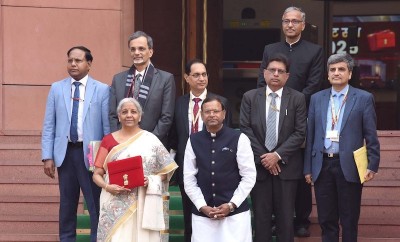 RBI
RBI
RBI MPC meeting: Central bank keeps repo rate unchanged at 6.5%, stance changed to 'neutral'
New Delhi/IBNS: The Reserve Bank of India's (RBI) reconstituted Monetary Policy Committee (MPC), which met from October 7 to 9, announced on Wednesday (Oct. 9) that it would keep the benchmark repo rate unchanged at 6.5 percent.
This marks the tenth consecutive monetary policy review where the key policy rate has been kept unchanged.
In a notable shift, the six-member MPC also changed its monetary policy stance from "withdrawal of accommodation" to "neutral," while keeping the projections for retail inflation and GDP growth unchanged at 4.5 percent and 7.2 percent for FY2025, respectively.
The decision to keep the repo rate unchanged was supported by a 5:1 majority within the committee, with new MPC member Nagesh Kumar, Director and Chief Executive of the Institute for Studies in Industrial Development, advocating for a 25-basis point reduction in the rate.
RBI Governor Shaktikanta Das explained that inflation for September is expected to rise sharply due to unfavorable base effects and increasing food prices.
While the inflation rate is anticipated to moderate in the fourth quarter of the year, Das cautioned that unforeseen weather events and geopolitical tensions pose significant risks to inflation moving forward.
The shift from a "withdrawal of accommodation" stance signals that the RBI no longer plans to take steps to tighten the money supply.
Previously, the RBI had pursued this stance to curb inflation while supporting economic growth.
However, the MPC reiterated that its policy focus remains on achieving a "durable alignment" of inflation with the target, while also promoting growth.
The adoption of a neutral stance allows the central bank greater flexibility in navigating evolving economic conditions.
By keeping the repo rate steady at 6.5 percent, borrowers linked to external benchmark lending rates (EBLR), which are tied to the repo rate, will find relief, as their equated monthly installments (EMIs) will not increase.
However, interest rates on loans tied to the marginal cost of fund-based lending rate (MCLR) could rise, as the full transmission of the 250-basis point hike in the repo rate, implemented between May 2022 and February 2023, has not yet been fully reflected in those rates.
Governor Das pointed out that the inflation spike in September is partly due to the lingering impact of a reduced output of key food items like onions, potatoes, and chana dal (gram) during 2023-24.
However, the headline inflation rate is projected to moderate in the fourth quarter, aided by a good kharif harvest, sufficient buffer stocks of cereals, and favorable prospects for the upcoming rabi season.
Nonetheless, risks to inflation remain, driven by unpredictable weather events and escalating geopolitical conflicts.
International crude oil prices have been volatile in October, and rising food and metal prices, as observed in indices from the Food and Agriculture Organization (FAO) and the World Bank, pose additional risks if these trends persist, Das warned.
In response to the cumulative 250-basis point increase in the policy repo rate since May 2022, banks have adjusted their repo-linked external benchmark lending rates (EBLRs) by a similar amount.
The one-year median MCLR of banks has risen by 170 basis points between May 2022 and August 2024.
Looking ahead, there are growing expectations that the RBI may implement its first repo rate cut in December 2024, offering potential relief to borrowers and signaling a shift in the monetary policy cycle.
Support Our Journalism
We cannot do without you.. your contribution supports unbiased journalism
IBNS is not driven by any ism- not wokeism, not racism, not skewed secularism, not hyper right-wing or left liberal ideals, nor by any hardline religious beliefs or hyper nationalism. We want to serve you good old objective news, as they are. We do not judge or preach. We let people decide for themselves. We only try to present factual and well-sourced news.







